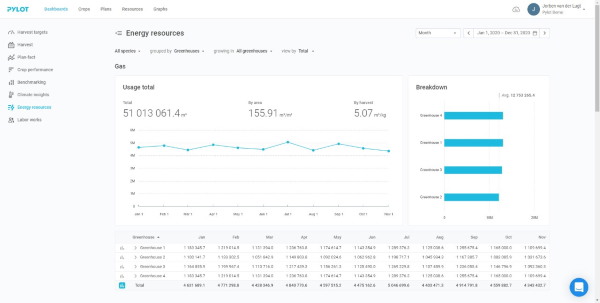With the functionality “Resources”, PYLOT has got another new feature. Growers using the platform can now easily record and analyse their consumption of gas, water and electricity. This information enables growers to further optimise their operational and cultivation strategy. Consumption data of various resources can be directly aligned with crop performance.

The consumption of gas, water and electricity makes up roughly 30% of the costs in operating a greenhouse, according to business manager Marc Rooijakkers. "Recording the consumption of these resources and linking this to cultivation cycles allows growers to gain greater insight into the performance of their crops in the greenhouse. You can tell how much gas, water and electricity was needed for each compartment by reading the corresponding meters in one overview. Linking this information to cultivation cycles will tell you which crop produced the highest yield and what amount of resources were required."
This functionality allows you to do more than just look at past performance, says Rooijakkers. "You can make subsequent adjustments to your cultivation strategy. Suppose you want to raise the greenhouse temperature by one degree: will this produce a higher yield and if so, does that outweigh the extra costs you have incurred? Thanks to Resources, you will be able to grow your crops even more efficiently. And strive for operational excellence."

Stand-alone systems
Through the introduction of Resources, PYLOT is responding to the wishes of growers who have hitherto relied on Excel sheets and other methods to gain an overview of their climate strategy, crop performance and usages of resources. "There are many stand-alone systems and applications on the market, but the strength of PYLOT is bringing all relevant data together. Making collecting and combining all relevant data from a greenhouse easier. Provide the manager and grower with insight and overview in a user friendly way. You can record a lot of data, but using this to its full potential is another story."
Expansions to PYLOT data platform are made in close consultation with managers and growers. "We have a constantly rotating panel of key users, who we consult and who have a major role in our strive for continuous development. PYLOT is a management tool made for and by managers and growers."
Further expansion
In the meantime, PYLOT is already working behind the scenes on the next expansion of the user-friendly data platform. This will also make it possible to record another important cost item in greenhouse horticulture: labour. More information about this will follow.
Benchmarking and incident management were added to the system a few months ago.
PYLOT can be integrated into the systems produced by the five leading manufacturers of horticulture-specific climate computers: Priva, Hoogendoorn, Hortimax, Fito (Russia) and Argus (USA). The data platform focuses on the five biggest vegetable crops in greenhouse horticulture: tomato, sweet pepper, cucumber, aubergine and lettuce.
For more information: Pylot
Pylot
[email protected]
www.pylot.nl
